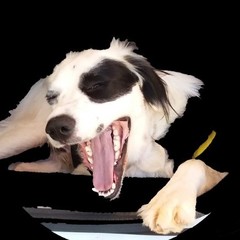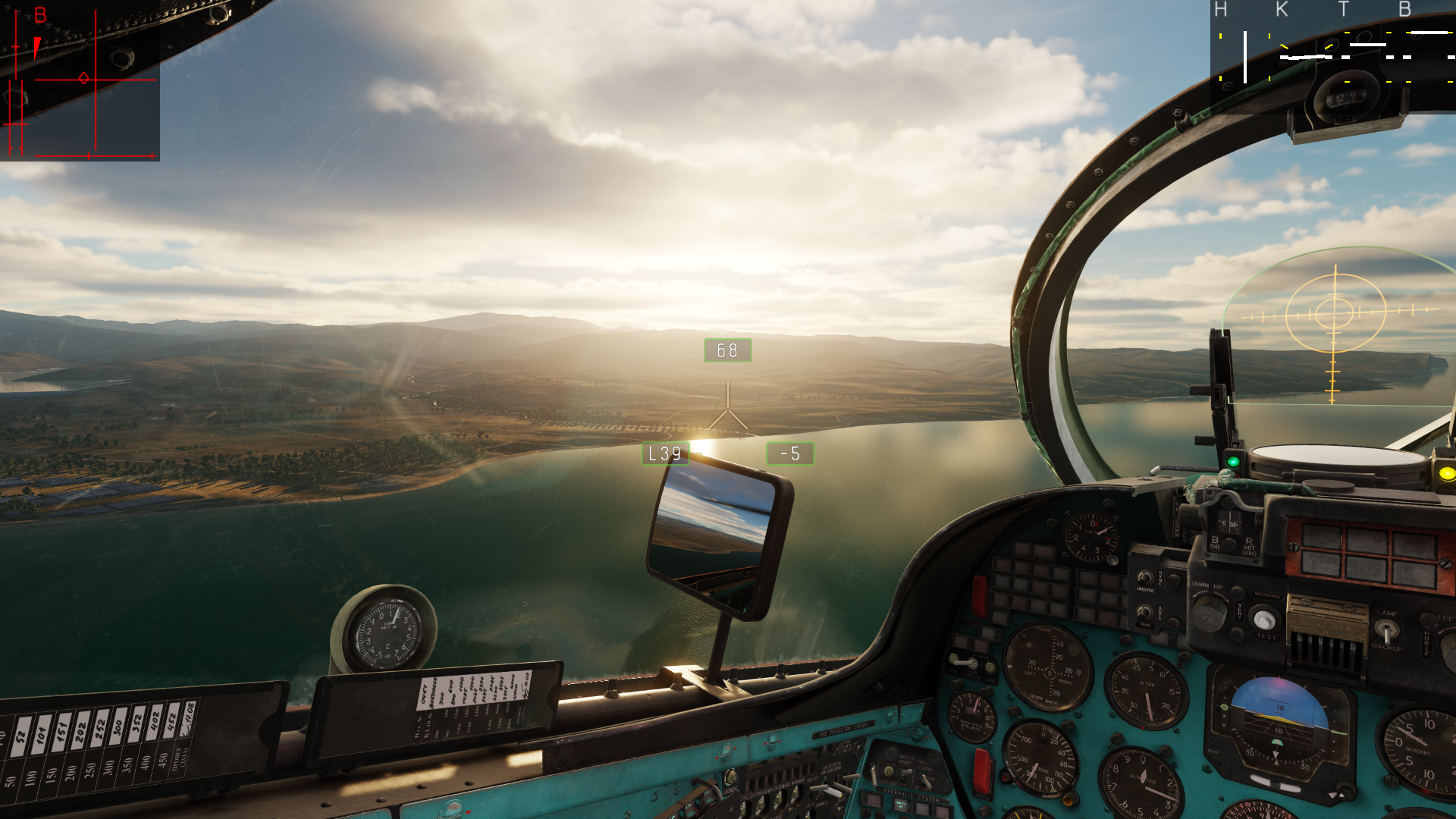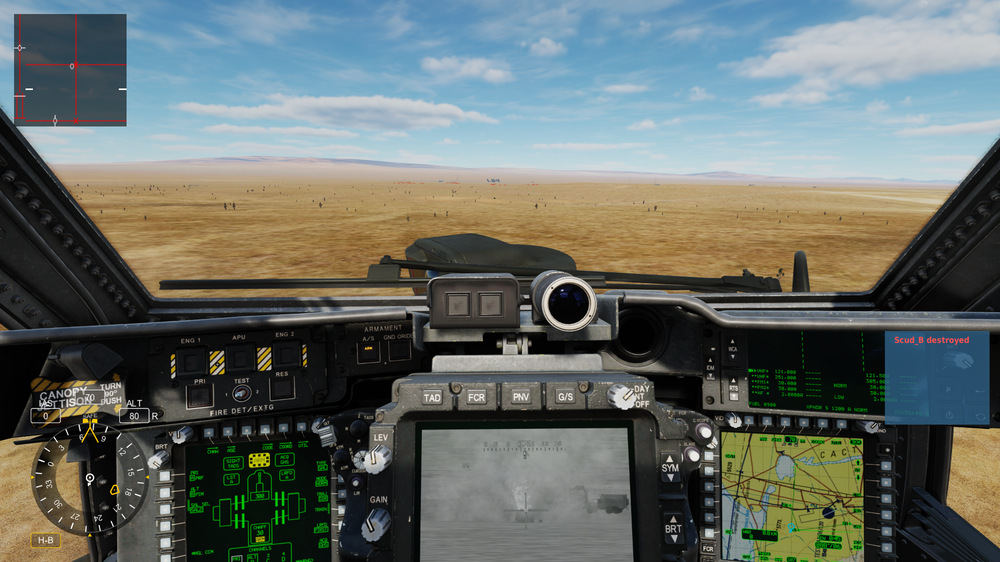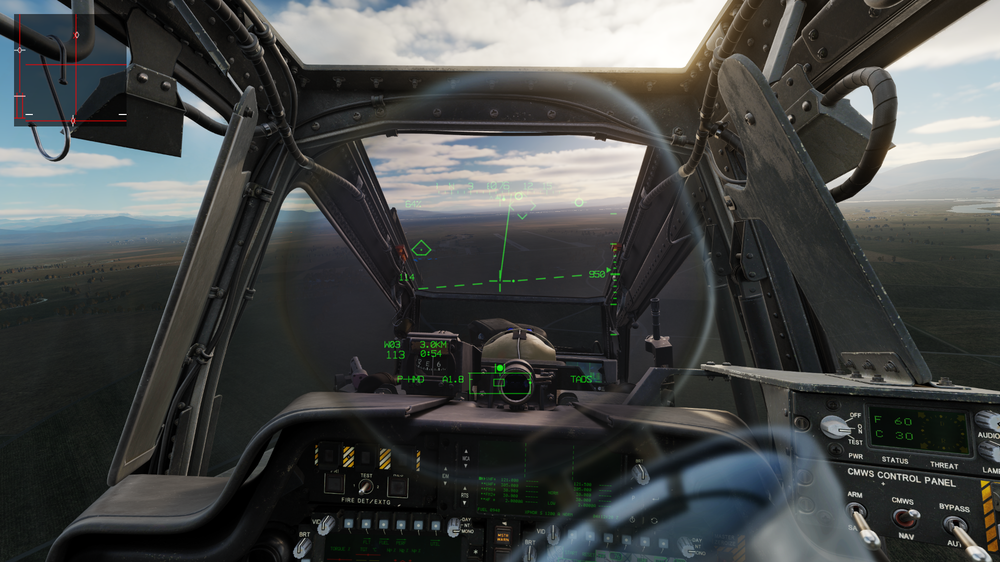-
Posts
636 -
Joined
-
Last visited
Content Type
Profiles
Forums
Events
Everything posted by RodBorza
-
There are some things that need to be addressed here: 1) The biggest misconception about the Apache is that it is a fast, agile helicopter. No it is not, it is heavy and sluggish, made to hide behind hills and to scoot and shoot. 2) Don't use the trim as you do in the Ka-50. In a real helicopter you would press the force trim button, put the helicopter whatever attitude you want, wait it to stabilize and release the force trim. In DCS it only works in the Ka-50. In all others choppers you need to move the cyclic, tap the trim, release control. With time you learn how to get good at it. Don't press the trim release to change attitude, it turns off the SCAS channel and then you have a wild horse on your hands. 3) The SCAS system fights you; it is made to fight any sudden change in attitude due to wind or other factors. However, as you input controls, it will fight you. Again, in real life you would press trim release which would inhibit the SCAS channels but not turn them off completely and the helo would allow you to input the controls as you pleased. But in DCS, as we know the trim release also turns off the stabilization channels and then you would have a wobbly bird. In the Apache, in particular if you input X, mainly on pedals, you need to take out Y, Y being less than X. Let's say you input right pedal, the SCAS system will fight this input by inputing left pedal, it does that automatically. So in order to stop your turn, you need to input left pedal, but less than you had input in the first place. It takes time to figure how to do this well, but with small, gentle controls you'll learn how to work with the SCAS, not against it. 4) and finally, I cannot recommend enough Schoolio64 and Eagle7 channels. The first is a former Apache pilot, the latter is a actual current civilian pilot. Both channels have amazing tips on how to tame this wild beast. https://youtu.be/Opq23ALBtI0
-

FLIR is bad, just me, realistic, or will be improved?
RodBorza replied to truebrit's topic in DCS: AH-64D
FLIR is not bad, it is in fact as realistic as we can have on game. The question is: were the targets with engine on and moving? Were they still? If they are still for some time, or set like that in the Mission Editor, it will be very difficult to spot them due to the lack of difference between their temperature and the surrounding terrain, If you test it during the day you will se the vehicles temperature different of that of the ground. Or at night, if you set the vehicles to move around, you will spot them more easily. -
I don't know exactly what is happening, but what you could do is to check if you are on the NAV or ATK phases on TADS. If you are on NAV, the Targets won't show up or be stored. In order to set any point as acquisition source, what you do is go to the Point Page, and choose any coordinate, be it Waypoint, Control Measure or Target and click on the left side button. If you click on the right one it will show details, the left one sets it as your desired ACQ. Also, on the Wepons page, if you click the ACQ option, it will open the same page and you can choose your ACQ point from there.
-
I have an old Logitech Rudder Pedals and also, after 6 miliion screws and lots of elbow grease later, they work fine. My curve for rudder pedal is 25, with 90 Y Saturation. Yes, I lose the 100% travel on the rudder, but who needs it: if you are using 100% pedal on a helicopter you are doing it wrong. Also, 90 Y Saturation gives me a better resolution, so it is not that twitchy. And, most importantly, the SCAS system works for you, although it seems the opposite. If you press RCrtl+Enter twice you'll see the controls indicator on the left, and the SCAS channels on the upper right. Although its initials are in russian, pay attention to the "H" channel, the vertical one. It shows the amount of input the SCAS system is inserting on the system. I don't know if you have experience on other choppers in DCS, but normally, for instance a hover, you need to input X to turn right and then take out the same amount X to stop rotation where you want the nose to be pointing at. But with the SCAS system on the Apache, if you, for instance, want to turn right, you input X amount of right pedal and the need to take out Y amount of rudder, being Y less than X. And why does that happen? Because the SCAS system is trying to compensate for the movement to the right you are doing, by inputing some left pedal in. Yes, it is fighting your inputs. But, if you starting doing what I said, input X and take out Y, you will see that once you remove pedal input the SCAS system will stop and maintain heading exactly where you want it to be. I believe it is not the right way things should work, the right thing is to press trim, then the SCAS would disengage, you would point wherever you want and then release trim so the SCAS system would maintain the desired heading. However, as it is already known, if you press the trim button and try to change attitude, the system turns off and you have an uncontrollable bird on your hand. So, the best thing that is working for me, on the yaw channel, is to input a certain amount and take out that input by a lesser amount. And tap trim, move, tap trim, move, tap trim, move... Ans regarding curves, maybe this helps:
-

Ah-64D flying difficulty and comparison to others helis
RodBorza replied to Fukitsuna's topic in DCS: AH-64D
Interesting point. I will test it out. Enviado de meu SM-A127M usando o Tapatalk -

Ah-64D flying difficulty and comparison to others helis
RodBorza replied to Fukitsuna's topic in DCS: AH-64D
It is exactly what it is doing: working against you. The Stability systems function is to react against anything that makes the helo get out of its last state. It includes the pilot. AND, in DCS the system being what it is, yes, the system will fight you, because we move and tap the trim . It is a shame that once we press the trim, the SCAS channels say good bye and leave you with a less stable aircraft. I hope they solve this issue one day, on the KA-50 it works as intended. -

Ah-64D flying difficulty and comparison to others helis
RodBorza replied to Fukitsuna's topic in DCS: AH-64D
Not even taping it? Because one thing I've learned the hard way is to NOT use the force trim as a real pilot would. It only works on the Ka-50. Press it, move where you want, and then release. For all others, including the Uh-60 mod, if you press the trim, you loose control. What I, and many others do, is to me the controls where I want, and then tap it? Then the control will move there and stay there. And, yes, I also believe there is something strange with the FCS, mainly at low speed with the yaw channel. Too sensitive. Enviado de meu SM-A127M usando o Tapatalk -

Ah-64D flying difficulty and comparison to others helis
RodBorza replied to Fukitsuna's topic in DCS: AH-64D
Well, have you tried what Rifter said on his post? I'm doing what he said and it has been working. It works fine for higher speed and for hover IF I don't have to input rudder. What I'm doing now is to command the chopper and what to see what it will do. THE SCAS system will kick in and stabilize the chopper. You don't need to be putting in and taking out as we do in the Huey. And if you do that, you have to make sure that the amount you take out is less than what you've put in, because the SCAS system will do most of the work for you. And you must wait for the chopper to stabilize on its own. The only situation That I see myself reacting quickly on the controls is when using pedals for hover. But, again, make sure that the amount of pedal you take out is less than what you put in. Works like this: If I'm in a hover, and I want to turn right, I will slowly press pedal right. What I would normally expect to do then, is to take out the amount I've just put in, but that is not needed. What I need to do to stop the rotation is to then take out a smaller amount of left rudder, because the SCAS is already trying to stabilzia the helicopter and it will do at least half of the work for you. Try and use the CRTL+Enter controls indicator twice. On the up right corner a schematic will appear showing how the SCAS is working. Its initials are in Russian, but with time you get used to it. You'll see that sometimes you won't be inputting any anti-torque pedal and the "H" indicator (vertical line) will be to one side or another, indicating that the SCAS is working and compensating. Also, the green lines on the left control indicator show what the SCAS is doing. All in all, I hope it helps you to tame this beast. We have to unlearn what we do in the Huey and learn how to work with the SCAS for our benefit. And, maybe this helps as well: -
It is something that bugs me as well. Everytime I try to mimic real life behavior, be in the Apache, the KA-50, the UH-60 (mod), it seems that SCAS is turned off and I lose control. I don't believe the real helicopters are like that, because the pilot needs to press the trim button, adjust the position they want,and let the trim go. It never works for me. The controls seem to get VERY loose, the helicopters get all over the place, mainly in landings or take offs. So, what I do is I change the position of the controls to where I want them to be and then tap the trim. It is not reallistic, but it is what works. It works for the Apache, the UH-60, the Huey, the Hind and the Gazelle. Sometimes it doesn't work for the KA-50, sometimes that one needs to trim to be pressed for some seconds to lock in the position I want. But I usually don't press the trim button to move the controls, only tap it.
-

DCS: AH-64D Screenshots and Videos (NO DISCUSSION)
RodBorza replied to Sleepy's topic in DCS: AH-64D
Being George is fun too! These images bring me so many nostalgic memories from good old Jane's Longbow 2. -
Try to change the Pedals to No Spring FFB. And then, use curvature 0 and 90 on Y curvature. The solution is not set curves, because they get very sluggish at the start of input, and then they suddenly increase. The important thing is to reduce the rate at which movement occurs. Then start changing curvature to your liking. Mine is set at 20 and 90 Y curvature. And use collective very, very slowly. The torque onset on the Apache is much greater than other DCS helos.
-
After you selected Senaki, did you press the "Tune" option? I was having the same problem until I read on the manual that you have to press that darn little button on the TSD.
-
One of the nice details I've discovered about this aircraft is that if you select and NDB station from a Preset ADF frequency present on the Helo, besides all the usual indications for doing Radio Navigation, the Station you selected will appear as a Direct-To point on the TSD and HMD. Cool little detail that helps a lot flying instrument approaches. Here is the approach to Kutaisi.
-
Yes, I've found it to be very wobbly, much worst than the Huey. The Huey I can master, the Ka-50 for me is flyable, the Hind is great once you learn how to live with the automatic rudder. But the Ah-64 is a wild Bronco. NineLine posted that you must disable the games avionics and game flight model on the options page, as it seems to be causing a lot of trouble. Also, some people are reporting that this lack of control issue is happening on the Instant Action missions and whenever you get the bird on a hot start. On training missions it seems that the helo works well.
-

Trimmer choices for regular joysticks
RodBorza replied to sobe's topic in Controller Questions and Bugs
Same here. Flying with FFB INSTANT TRIM on is easy. Central Position Trimmer is all over the place, really unflyable. Same goes to my pedals. I have no springs in may pedals, and if I use the NO SPRING AND FFB option it goes everywhere, too sensitive. With FFB INSTANT TRIM is ok. -

Engine bearings and how you can keep them happy
RodBorza replied to Diesel_Thunder's topic in DCS: P-47 Thunderbolt
Thank you fro this. I'm RE-learning this bird since last updates. A different beast than before, no doubt about it, since now we have engine damage model one. Yesterday I broke the engine in a steep dive and didn't know why, the debriefing page just said ENGINE MAIN BEARING DAMAGE. That's what got me to your post. Makes sense now. Now I'm using the prop +throttle attached technique and it is working fine. Boost off, for good measure. And regarding all this discussion about landings, what I do and ever did was to go full RPM during the pattern, using throttle to control the power, very fast on turns (~150 mph) and final speed around 1110-120 mph. After I cross the threshold I take out the throttle and flare to touch down around 90 mph. Works fine in every allied bird I've flown. Don't know how other pilots can land this bird on throttle idle on final. I find it very heavy to do that. Anyway, everyone finds what it is best for them. As long we don't destroy the bird on landing, everything is fine. -

Why P-47 is so much harder to control than P-51?
RodBorza replied to brucewhf's topic in DCS: P-47 Thunderbolt
Use the curves, Luke! Also, the P-47 also has lots of torque, and any change on any setting of RPM or Manifold pressure, or boost, will change torque and will take the aircraft out of balance. You need to be always inputting rudder, always. I always keep an eye on the ball in the slip indicator, if you pay attention to it, you'll see that the ball moves like crazy to one side or the other. But once you apply rudder or rudder trim, you'll have a much more stable aircraft. My curves are 24 for pitch, roll and rudder axis. -
There is something similar to the Huey, which does not have an autopilot, but you can engage an Autopilot AI and it works as if the other pilot had taken the controls. It works great if you wanna mess with the radios or instruments. They could implement something similar in the Mosquito, where the pilot could maintain it flying straight and level while you fiddle with the radios and navigation, etc.
-
Yep, I found the same error on the same page. Also: On Page 27 last paragraph reads: "Both mail landing gear..." - should be "Both main landing gear..." On Page 96, second paragraph under Engine Oil Pressure (PSI) reads "When the oil pressure of an engine is above 120 PSI but below 23 PSI,..." I believe it should read "...120 PSI or below 23 PSI,..." On Page 97 the aforementioned error; On Page 99, second paragraph under Engine/Nose Gearbox (NGB) Oil., reads "When the oil pressure of an engine is above 120 PSI but below 23 PSI,..." I believe it should read "...120 PSI or below 23 PSI,..." On Page 103 under Stabilator Position, second phrase on the paragraph reads: "The position is shown graphically on an arc from -10º to +35º,..." I believe it should read "The position is shown graphically on an arc from -35º to +10º,..." since on page 100, under Stabilator Status it is stated that "The angle is referenced to the trailing edge of the stabilator and displays a range of 10° UP to -35° DN." Hope this helps to correct some minor things on an already great manual, well written direct to the point, simple even with all that plethora of sub-systems that the Apache has.
-

Engine exhaust flames. Are they realistic?
RodBorza replied to Terry Dactil's topic in DCS: Mosquito FB VI
I understand it is not realistic and all, but there are some nice features. Have you tried changing the mixture from rich to poor and watching the flames? It is a cool detail. -
Flying Instrument on the Huey is a great exerciser. This old tech makes you get very creative when instrument flying. Set up bad weather on the Caucasus and try to get from Batumi to Senakhi. Or from Kobuleti to Tblisi, following the beacons. It is very satisfying.
-
Check the knob position on your radio panel. It may be in the TEST position. I know, panel views on the Huey are not the best. But you can check if the ILS is working or not by looking at the needles on RMI. If the selector is in the OFF position, both needles will be crossed and the orange GS and LOC flags will be on. If the selector is in the TEST position, all of the above plus the blue light on as you mentioned above. That's why your needles were centered all the time. If the Selector is in the PWR position, you need to set the ILS direction on your RMI with the OBS button. In the case of Akrotiri, it is 291º. Then you should see the Localizer needle to the left or the right, and the GS flag on. Once you are in the GS range, the horizontal needle should start moving and the GS flag stowed away
-
Besides the double binds and curve sensitivity settings, the trim over sensitivity is a very well know problem. You can try this mod, found here. I've tried, and had success on trimming all my war birds straight and level. Also, remember that torque plays an important part on all of it. If you change prop settings, you have to trim; if you change manifold pressure; you have to trim; if you turn...you got the idea. Heck, you even have to trim from time to time because the aircraft gets lighter as it burns fuel. But with the aforementioned mod you can trim the war birds more easily. I even went further and changed the rate of change of the aircraft propeller, now I can se the rpm whatever I want without it jumping like crazy.






